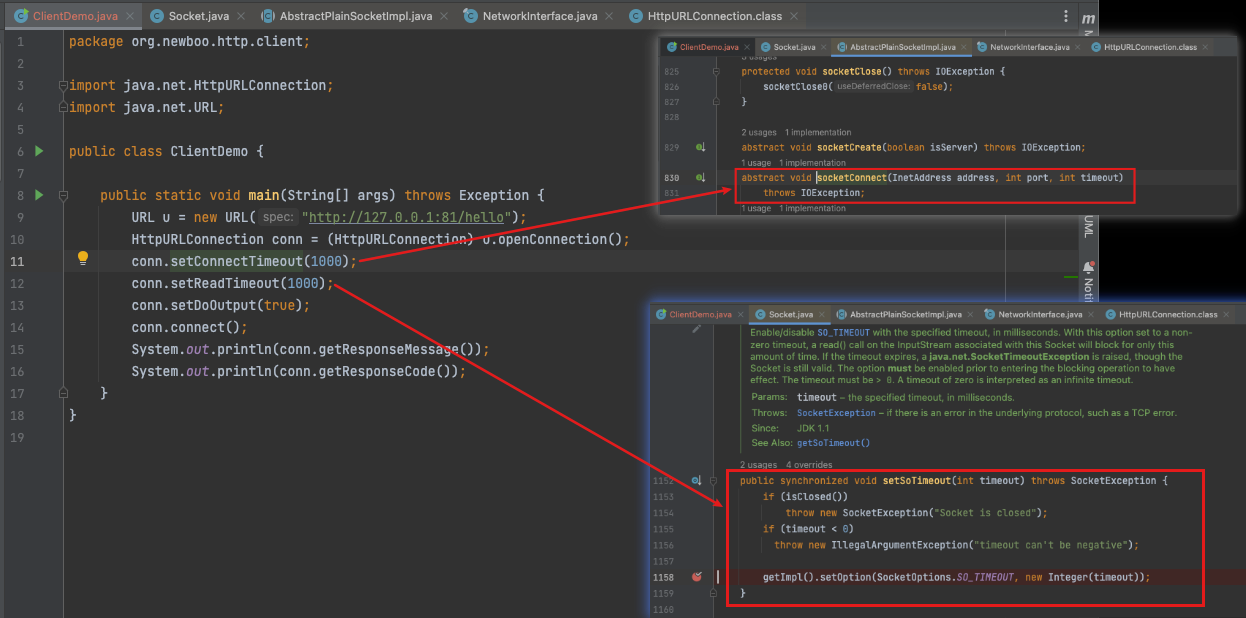hello,大家好呀,我是既写 Java 又写 Go 的小楼,在写 Go 的过程中经常对比这两种语言的特性,踩了不少坑,也发现了不少有意思的地方,今天就来聊聊 Go 自带的 HttpClient 的超时机制。
Java HttpClient 超时底层原理
在介绍 Go 的 HttpClient 超时机制之前,我们先看看 Java 是如何实现超时的。
写一个 Java 原生的 HttpClient,设置连接超时、读取超时时间分别对应到底层的方法分别是:
再追溯到 JVM 源码,发现是对系统调用的封装,其实不光是 Java,大部分的编程语言都借助了操作系统提供的超时能力。
然而 Go 的 HttpClient 却提供了另一种超时机制,挺有意思,我们来盘一盘。但在开始之前,我们先了解一下 Go 的 Context。
Go Context 简介
Context 是什么?
根据 Go 源码的注释:
// A Context carries a deadline, a cancellation signal, and other values across// API boundaries.// Context's methods may be called by multiple goroutines simultaneously.
Context 简单来说是一个可以携带超时时间、取消信号和其他数据的接口,Context 的方法会被多个协程同时调用。
Context 有点类似 Java 的 ThreadLocal,可以在线程中传递数据,但又不完全相同,它是显示传递,ThreadLocal 是隐式传递,除了传递数据之外,Context 还能携带超时时间、取消信号。
Context 只是定义了接口,具体的实现在 Go 中提供了几个:
针对 Context 的三个特性,可以通过 Go 提供的 Context 实现以及源码中的例子来进一步了解下。
Context 三个特性例子
这部分的例子来源于 Go 的源码,位于 src/context/example_test.go
携带数据
使用 context.WithValue 来携带,使用 Value 来取值,源码中的例子如下:
// 来自 src/context/example_test.gofunc ExampleWithValue() { type favContextKey string
f := func(ctx context.Context, k favContextKey) { if v := ctx.Value(k); v != nil { fmt.Println("found value:", v) return } fmt.Println("key not found:", k) }
k := favContextKey("language") ctx := context.WithValue(context.Background(), k, "Go")
f(ctx, k) f(ctx, favContextKey("color"))
// Output: // found value: Go // key not found: color}
复制代码
取消
先起一个协程执行一个死循环,不停地往 channel 中写数据,同时监听 ctx.Done() 的事件
// 来自 src/context/example_test.gogen := func(ctx context.Context) <-chan int { dst := make(chan int) n := 1 go func() { for { select { case <-ctx.Done(): return // returning not to leak the goroutine case dst <- n: n++ } } }() return dst }
复制代码
然后通过 context.WithCancel 生成一个可取消的 Context,传入 gen 方法,直到 gen 返回 5 时,调用 cancel 取消 gen 方法的执行。
// 来自 src/context/example_test.goctx, cancel := context.WithCancel(context.Background())defer cancel() // cancel when we are finished consuming integers
for n := range gen(ctx) { fmt.Println(n) if n == 5 { break }}// Output:// 1// 2// 3// 4// 5
复制代码
这么看起来,可以简单理解为在一个协程的循环中埋入结束标志,另一个协程去设置这个结束标志。
超时
有了 cancel 的铺垫,超时就好理解了,cancel 是手动取消,超时是自动取消,只要起一个定时的协程,到时间后执行 cancel 即可。
设置超时时间有 2 种方式:context.WithTimeout 与 context.WithDeadline,WithTimeout 是设置一段时间后,WithDeadline 是设置一个截止时间点,WithTimeout 最终也会转换为 WithDeadline。
// 来自 src/context/example_test.gofunc ExampleWithTimeout() { // Pass a context with a timeout to tell a blocking function that it // should abandon its work after the timeout elapses. ctx, cancel := context.WithTimeout(context.Background(), shortDuration) defer cancel()
select { case <-time.After(1 * time.Second): fmt.Println("overslept") case <-ctx.Done(): fmt.Println(ctx.Err()) // prints "context deadline exceeded" }
// Output: // context deadline exceeded}
复制代码
Go HttpClient 的另一种超时机制
基于 Context 可以设置任意代码段执行的超时机制,就可以设计一种脱离操作系统能力的请求超时能力。
超时机制简介
看一下 Go 的 HttpClient 超时配置说明:
client := http.Client{ Timeout: 10 * time.Second, } // 来自 src/net/http/client.go type Client struct { // ... 省略其他字段 // Timeout specifies a time limit for requests made by this // Client. The timeout includes connection time, any // redirects, and reading the response body. The timer remains // running after Get, Head, Post, or Do return and will // interrupt reading of the Response.Body. // // A Timeout of zero means no timeout. // // The Client cancels requests to the underlying Transport // as if the Request's Context ended. // // For compatibility, the Client will also use the deprecated // CancelRequest method on Transport if found. New // RoundTripper implementations should use the Request's Context // for cancellation instead of implementing CancelRequest. Timeout time.Duration}
复制代码
翻译一下注释:Timeout 包括了连接、redirect、读取数据的时间,定时器会在 Timeout 时间后打断数据的读取,设为 0 则没有超时限制。
也就是说这个超时是一个请求的总体超时时间,而不必再分别去设置连接超时、读取超时等等。
这对于使用者来说可能是一个更好的选择,大部分场景,使用者不必关心到底是哪部分导致的超时,而只是想这个 HTTP 请求整体什么时候能返回。
超时机制底层原理
以一个最简单的例子来阐述超时机制的底层原理。
这里我起了一个本地服务,用 Go HttpClient 去请求,超时时间设置为 10 分钟,建议使 Debug 时设置长一点,否则可能超时导致无法走完全流程。
client := http.Client{ Timeout: 10 * time.Minute, } resp, err := client.Get("http://127.0.0.1:81/hello")
复制代码
1. 根据 timeout 计算出超时的时间点
// 来自 src/net/http/client.godeadline = c.deadline()
复制代码
2. 设置请求的 cancel
// 来自 src/net/http/client.gostopTimer, didTimeout := setRequestCancel(req, rt, deadline)
复制代码
这里返回的 stopTimer 就是可以手动 cancel 的方法,didTimeout 是判断是否超时的方法。这两个可以理解为回调方法,调用 stopTimer() 可以手动 cancel,调用 didTimeout() 可以返回是否超时。
设置的主要代码其实就是将请求的 Context 替换为 cancelCtx,后续所有的操作都将携带这个 cancelCtx:
// 来自 src/net/http/client.govar cancelCtx func()if oldCtx := req.Context(); timeBeforeContextDeadline(deadline, oldCtx) { req.ctx, cancelCtx = context.WithDeadline(oldCtx, deadline)}
复制代码
同时,再起一个定时器,当超时时间到了之后,将 timedOut 设置为 true,再调用 doCancel(),doCancel() 是调用真正 RoundTripper (代表一个 HTTP 请求事务)的 CancelRequest,也就是取消请求,这个跟实现有关。
// 来自 src/net/http/client.gotimer := time.NewTimer(time.Until(deadline))var timedOut atomicBool
go func() { select { case <-initialReqCancel: doCancel() timer.Stop() case <-timer.C: timedOut.setTrue() doCancel() case <-stopTimerCh: timer.Stop() }}()
复制代码
Go 默认 RoundTripper CancelRequest 实现是关闭这个连接
// 位于 src/net/http/transport.go// CancelRequest cancels an in-flight request by closing its connection.// CancelRequest should only be called after RoundTrip has returned.func (t *Transport) CancelRequest(req *Request) { t.cancelRequest(cancelKey{req}, errRequestCanceled)}
复制代码
3. 获取连接
// 位于 src/net/http/transport.gofor { select { case <-ctx.Done(): req.closeBody() return nil, ctx.Err() default: }
// ... pconn, err := t.getConn(treq, cm) // ...}
复制代码
代码的开头监听 ctx.Done,如果超时则直接返回,使用 for 循环主要是为了请求的重试。
后续的 getConn 是阻塞的,代码比较长,挑重点说,先看看有没有空闲连接,如果有则直接返回
// 位于 src/net/http/transport.go// Queue for idle connection.if delivered := t.queueForIdleConn(w); delivered { // ... return pc, nil}
复制代码
如果没有空闲连接,起个协程去异步建立,建立成功再通知主协程
// 位于 src/net/http/transport.go// Queue for permission to dial.t.queueForDial(w)
复制代码
再接着是一个 select 等待连接建立成功、超时或者主动取消,这就实现了在连接过程中的超时
// 位于 src/net/http/transport.go// Wait for completion or cancellation.select {case <-w.ready: // ... return w.pc, w.errcase <-req.Cancel: return nil, errRequestCanceledConncase <-req.Context().Done(): return nil, req.Context().Err()case err := <-cancelc: if err == errRequestCanceled { err = errRequestCanceledConn } return nil, err}
复制代码
4. 读写数据
在上一条连接建立的时候,每个链接还偷偷起了两个协程,一个负责往连接中写入数据,另一个负责读数据,他们都监听了相应的 channel。
// 位于 src/net/http/transport.gogo pconn.readLoop()go pconn.writeLoop()
复制代码
其中 wirteLoop 监听来自主协程的数据,并往连接中写入
// 位于 src/net/http/transport.gofunc (pc *persistConn) writeLoop() { defer close(pc.writeLoopDone) for { select { case wr := <-pc.writech: startBytesWritten := pc.nwrite err := wr.req.Request.write(pc.bw, pc.isProxy, wr.req.extra, pc.waitForContinue(wr.continueCh)) // ... if err != nil { pc.close(err) return } case <-pc.closech: return } }}
复制代码
同理,readLoop 读取响应数据,并写回主协程。读与写的过程中如果超时了,连接将被关闭,报错退出。
超时机制小结
Go 的这种请求超时机制,可随时终止请求,可设置整个请求的超时时间。其实现主要依赖协程、channel、select 机制的配合。总结出套路是:
主协程生成 cancelCtx,传递给子协程,主协程与子协程之间用 channel 通信
主协程 select channel 和 cancelCtx.Done,子协程完成或取消则 return
循环任务:子协程起一个循环处理,每次循环开始都 select cancelCtx.Done,如果完成或取消则退出
阻塞任务:子协程 select 阻塞任务与 cancelCtx.Done,阻塞任务处理完或取消则退出
以循环任务为例
Java 能实现这种超时机制吗
直接说结论:暂时不行。
首先 Java 的线程太重,像 Go 这样一次请求开了这么多协程,换成线程性能会大打折扣。
其次 Go 的 channel 虽然和 Java 的阻塞队列类似,但 Go 的 select 是多路复用机制,Java 暂时无法实现,即无法监听多个队列是否有数据到达。所以综合来看 Java 暂时无法实现类似机制。
总结
本文介绍了 Go 另类且有趣的 HTTP 超时机制,并且分析了底层实现原理,归纳出了这种机制的套路,如果我们写 Go 代码,也可以如此模仿,让代码更 Go。这期是我写的 Go 底层原理第一期,求个 赞、在看、分享,我们下期再见。













评论